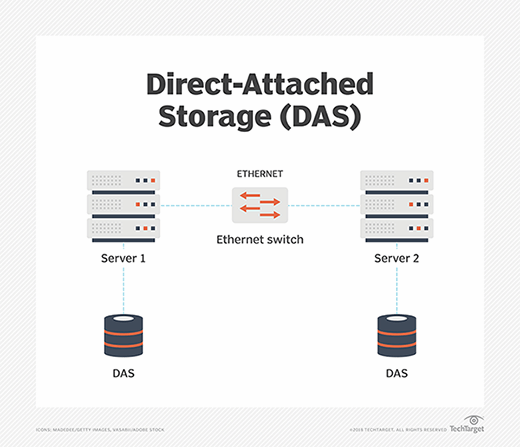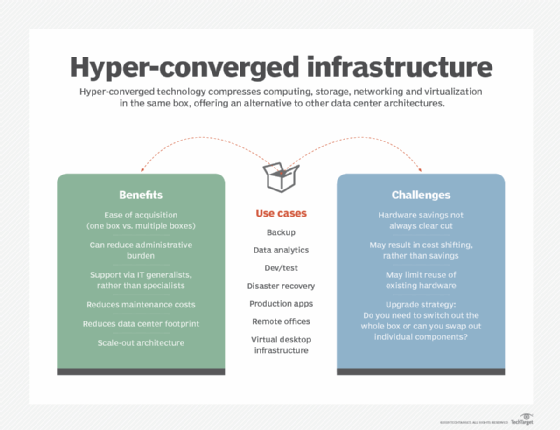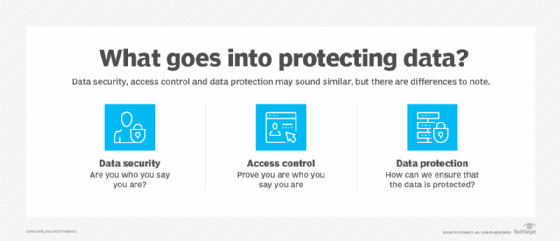Direct-attached storage (DAS) is a sort of information storage that’s hooked up on to a pc with out going by means of a community. The storage is perhaps linked internally or externally. Solely the host laptop can entry the information immediately. Different gadgets should undergo the host laptop to work with the information.
Most servers, desktops and laptops comprise an inner arduous disk drive (HDD) or solid-state drive (SSD). Every of those gadgets is a type of direct-attached storage. Some computer systems additionally use exterior DAS gadgets. In some circumstances, an enterprise server may join on to drives which might be shared by different servers.
A direct-attached storage gadget isn’t networked. There are not any connections by means of Ethernet or Fibre Channel (FC) switches, as is the case for network-attached storage (NAS) or a storage space community (SAN).
An exterior DAS gadget establishes a direct connection to a pc by means of an interface reminiscent of Small Pc System Interface (SCSI), Serial Superior Know-how Attachment (SATA), Serial-Connected SCSI (SAS), FC or Web SCSI (iSCSI). The gadget attaches to a card plugged into an inner bus on the pc. These storage media applied sciences can be utilized for DAS:
- Arduous disk drives. HDDs use rotating disks for storage and are utilized in quite a lot of gadgets.
- Stable-state drives. SSDs are quick, high-capacity, nonmechanical drives that compete with HDDs.
- Exterior arduous drives. Storage drives linked to a server or different computing gadget by way of USB, Thunderbolt or eSATA ports.
- {Hardware} RAID arrays. RAID leverages a number of drives with totally different logic preparations to extend efficiency and supply information redundancy.
- Flash drives. Flash drives are sometimes SSDs applied in handy type components, reminiscent of USB thumb drives.
- Storage enlargement playing cards. These embody assist for non-volatile reminiscence categorical (NVMe) SSDs that join by way of inner Peripheral Element Interconnect Categorical (PCIe) slots.
Different forms of storage, reminiscent of optical storage gadgets and magnetic tape, are technically DAS as they’re immediately hooked up to a system, both internally or externally. Nonetheless, references to DAS are normally associated to storage gadgets, reminiscent of HDDs or SSDs.

Direct-attached storage professionals and cons
DAS can present customers with higher efficiency than networked storage as a result of the server doesn’t need to traverse a community to learn and write information, which is why many organizations use DAS for functions that require excessive efficiency. DAS can be less expensive and fewer advanced than network-based storage techniques, making it simpler to implement and preserve.
Further benefits of DAS embody:
- Simplified set up and configuration. Putting in DAS is so simple as inserting a storage drive into an accessible server slot with configuration dealt with by the server’s working system (OS).
- Price-effective. In comparison with different storage techniques, the price of putting in a DAS is nominal. No further software program is required along with the {hardware}, simplifying configuration modifications.
- Enhanced efficiency. DAS drives typically have low latency in comparison with networked storage; use of SSDs for DAS can vastly enhance efficiency.
- Safety. As DAS is immediately linked to the server, dangers of safety breaches to functions and information are lowered as networking know-how isn’t used.
DAS isn’t with out challenges, nevertheless. It has restricted scalability and lacks the kind of centralized administration and backup capabilities accessible to different storage platforms. Administrative instruments reminiscent of information replication, accessible in most SANs and NAS gadgets, may not be accessible with DAS. As well as, information can’t be simply shared and DAS would not facilitate failover ought to the server crash. Due to these challenges, standard types of DAS may not be suited for a lot of enterprise workloads.
Nonetheless, developments in virtualization applied sciences have breathed new life into DAS, a pattern that is been particularly obvious within the many hyperconverged infrastructure (HCI) techniques accessible from many {hardware} and software program distributors. An HCI system is made up of a number of server and DAS storage nodes, with the storage consolidated into logical useful resource swimming pools, offering a extra versatile storage resolution than standard DAS.

What are the variations between SAN, NAS and DAS?
NAS and SAN are networked storage techniques that pool storage capability and share it with software servers over a high-speed community.
In distinction, as famous earlier, DAS attaches on to the servers, which implies connectivity and expandability are each constrained by the variety of enlargement slots within the server. The scale of the DAS enclosure additionally restricts storage capability, and DAS is often restricted to a small variety of ports or host connections, making it tougher to share storage sources.
As well as, DAS typically lacks lots of the extra superior storage administration options frequent to NAS and SAN techniques, reminiscent of distant replication and snapshots. Though virtualization, HCI and different improvements are reinvigorating DAS, in addition they have some limitations.

On the plus aspect, DAS is cheaper than SAN or NAS and is less complicated to deploy when immediately plugged right into a server. Directors want solely join a brand new drive to a server to extend storage capability by as a lot as a number of terabytes. This has made DAS a sensible storage alternative for a lot of small and midsize companies (SMBs), the place storage prices and administrative overhead are issues.
Even when organizations use NAS or SANs, most bodily servers proceed in addition from DAS storage. The velocity of SSDs, specifically, makes booting domestically extra environment friendly than networked storage. Due to native SSDs, a bodily server can typically boot in only some seconds.
This velocity may be particularly helpful when a bodily server hosts digital machines that want to start out up shortly within the occasion of a crash or after scheduled downtime for service or upkeep.
Use circumstances for DAS
As famous earlier, DAS is often used for storing system startup information and functions. Further use circumstances can embody the next:
- Distant workplace, department workplace (ROBO) deployments. As famous earlier than, along with SMB functions, DAS makes fiscal sense for ROBO deployments, or for departmental functions in bigger companies.
- Utility internet hosting. In conditions the place a single software and its related information are all that’s wanted, DAS is perhaps a very good resolution.
- Knowledge safety. Noting that DAS is immediately linked and never topic to networking points, it may well present higher information safety, particularly in conditions the place compliance with particular information safety rules is required.
Safety points with direct-attached storage
As with all storage techniques that host a corporation’s crucial functions and information, safety is a main consideration when planning storage. To guard information saved on direct-attached storage, customers ought to do the next:
- Carry out an in-depth safety evaluation of the DAS surroundings. You may uncover vulnerabilities reminiscent of lax consumer permissions, lacking patches or misconfigured techniques.
- Run an audit of consumer permissions. Test consumer permissions and scan the DAS gadgets for unstructured information accessible to everybody on the server. As soon as that is achieved, lock down permissions. Additionally, take into account segmenting the server community to raised defend crucial DAS techniques.
- Make patching a precedence. Not maintaining with OS and software software program patches can depart your DAS susceptible to malfeasance. An intruder who beneficial properties entry to the DAS host can entry all information on that system, with out leaving proof that the system has been breached.
- Test the resiliency of the DAS system. Conduct enterprise continuity and fault tolerance testing. Give attention to lifelike system situations, reminiscent of storage {hardware} failures or the information heart being broken or destroyed.

DAS storage producers
Following is a quick record of DAS storage gadget producers that provide quite a lot of storage varieties:
- LaCie.
- QNAP.
- OWC.
- Samsung.
- Seagate.
- Toshiba.
- Water Panther.
- Western Digital (WD).
The impression of synthetic intelligence on DAS
As with different storage applied sciences, AI is anticipated to assist improve efficiency and performance of DAS within the coming years. Examples of how AI can impression DAS embody the next:
- Efficiency enhancements. Count on AI to optimize information storage and retrieval capabilities, whereas boosting throughput and lowering latency.
- Upkeep optimizing. By analyzing DAS efficiency in opposition to particular algorithms, AI may have the ability to avert potential disruptions, enhance upkeep and scale back downtime.
- Perform automation. Storage directors will have the ability to tackle extra urgent points as AI automates each day administrative duties.
- Safety enhancement. With early detection and prevention of safety breaches aided by AI, DAS techniques may be protected against cyberattacks reminiscent of hacking and ransomware.
- Enhanced scalability. Monitoring of DAS actions by AI can enhance storage scalability and flexibility to higher information volumes.
- Price administration. AI’s means to research and enhance DAS efficiency can contribute to simpler value administration.
Future DAS outlook and developments
Three essential applied sciences have come collectively to allow DAS to ship distinctive efficiency: flash-based SSDs, NVMe and PCIe.
Over time, flash storage has gotten sooner, denser and cheaper, however the conventional storage interfaces — notably SATA and SAS — couldn’t take full benefit of flash’s capabilities. This led to the event of NVMe, a logical gadget interface for direct-attached PCIe storage gadgets.
NVMe has been architected for higher-performance SSDs. It accelerates efficiency by exploiting PCIe parallelism by means of an optimized command set. PCIe is now in its fifth era.
Among the many essential developments for DAS storage are larger efficiency, utilizing the applied sciences above, and higher use of AI to reinforce safety and scalability, automate upkeep, enhance sustainability and ship cost-effectiveness.
Evaluate SAN, NAS and DAS and discover out what to contemplate when utilizing every kind of storage system. Object storage and the cloud are extra accessible storage choices.
…………………………………………
Sourcing from TechTarget.com & computerweekly.com
DYNAMIC ONLINE STORE
Subscribe Now
Leave a Reply